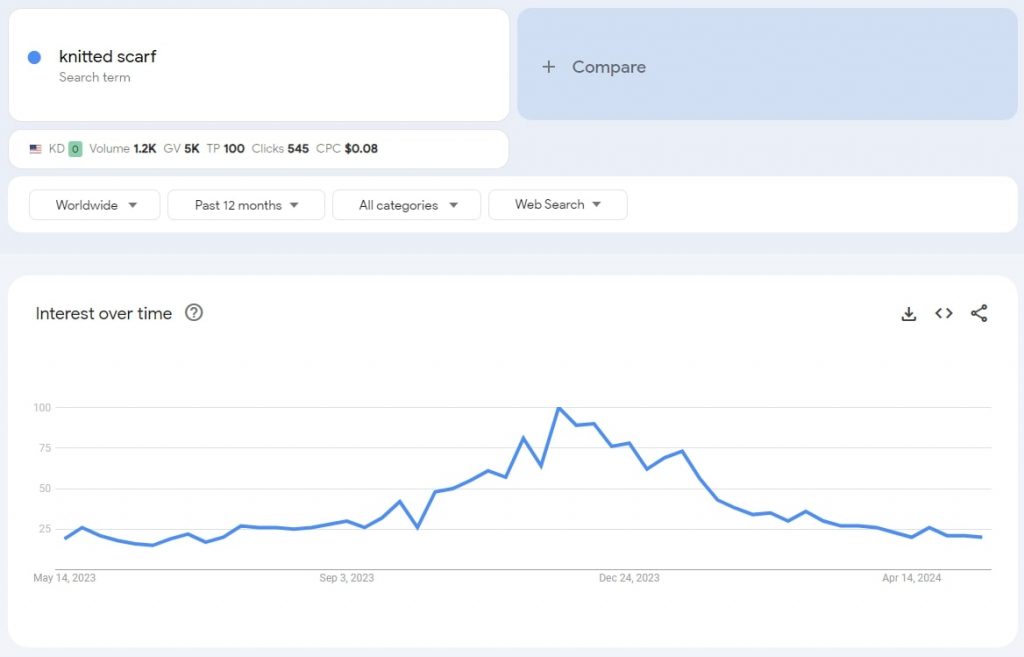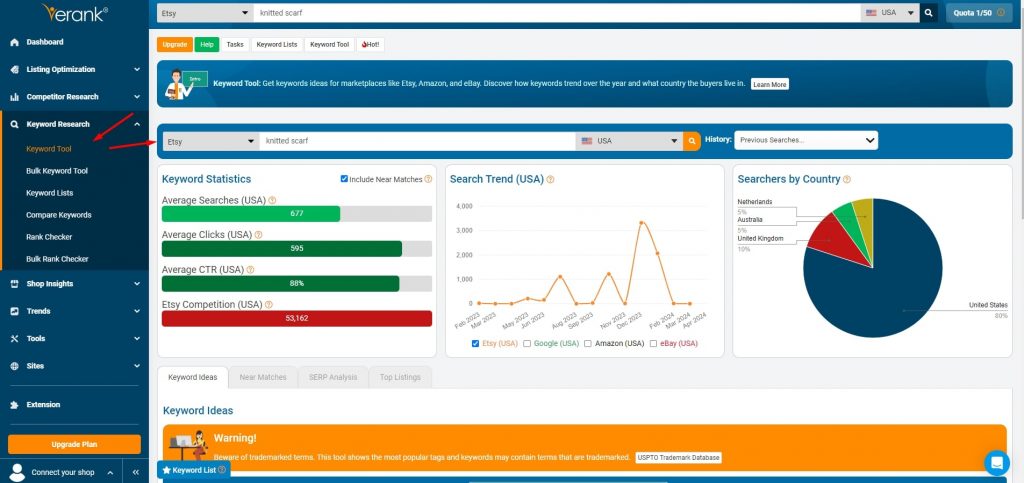With millions of shop owners worldwide and more than 90 million listings, Etsy is a bustling marketplace where standing out can be a challenge. However, the key to unlocking your Etsy shop’s full potential isn’t just about what you sell; it’s about understanding the market you operate within.
In this comprehensive guide, we’ll walk through ten essential steps to conducting thorough Etsy market research. This will ensure you’re not just adding to the marketplace’s stock but strategically positioning and selling your items for maximum impact.
Whether you’re new to Etsy or a seasoned seller looking for ways to revitalize your business, this guide is designed to help you at every step of the way, teaching you how to research Etsy trends and much more.
Identifying Your Target Audience
Before you can sell effectively, you need to know who you’re selling to. Identifying your target audience is the crucial first step to conducting effective research on the Etsy marketplace.
Follow these steps when identifying your target audience during Etsy market research:
Step 1: Define Your Product
- Clearly understand what you’re selling. Is it a practical item like hand-stitched leather wallets or a decorative piece like knitted wall hangings?
- Knowing your product’s purpose and aesthetic will guide your target audience research.
Step 2: Analyze Existing Customers (if applicable)
- If you already have an Etsy shop, look at your customer data. Analyze purchase history and demographics to identify trends.
- Who are your current buyers? Age, location, buying habits? Leverage the robust data provided by Etsy Analytics to understand the demographics and behavior of your current customers.
- Look for patterns in their search queries, favorite items, and purchase history to tailor your listings to their needs and preferences.
Step 3: Competitor Research
- Look at successful shops selling similar products.
- Analyze their customer interactions in reviews, comments, and social media engagement.
- Who are they talking to? What problems are their customers facing?
Step 4: Etsy Search Tools
- Use Etsy’s search tools to see what terms people use to find similar products.
- Look at search volume and competition for these keywords.
- This helps you understand what kind of audience is actively looking for these products.
Step 5: Dive Deeper into Your Niche
- Look for online communities related to your product niche.
- This could be forums, subreddits, Facebook groups, or Pinterest boards.
- See what kind of conversations are happening. What are people interested in, and what questions do they have?
Step 6: Develop Your Ideal Customer Persona
- Based on your research, create a profile of your ideal customer.
- Include demographics like age, location, income, interests, and online behavior.
- Psychographics like values, hobbies, and lifestyle choices can also be helpful.
Step 7: Refine and Repeat
- Your target audience may evolve as you gather more data.
- Regularly revisit your research and refine your ideal customer persona.
Analyzing Competitors
To gain a competitive edge in the Etsy marketplace, you must know who you’re competing against and what they’re doing right (or wrong).
Step 1: Identify Your Direct Competitors
- Search for similar products: Use relevant keywords on Etsy to find shops selling products similar to yours.
- Look at top sellers: Identify shops ranking high in search results or those with “Bestseller” badges.
- Check out established shops: Analyze successful shops within your niche, even if they’re not direct competitors.
Step 2: Deep Dive into Competitor Listings
- Product Offerings:
- Analyze the types of products they sell.
- Are there any unique variations or customizations offered?
- Identify any gaps in their product line where you could position yourself.
- Pricing Strategy:
- Compare their prices to yours.
- Are they targeting a budget-conscious or premium market?
- Consider how their pricing aligns with perceived value.
- Product Photography & Descriptions:
- Evaluate the quality and style of their product photos.
- Analyze the clarity, detail, and tone of their product descriptions.
- Identify areas where you can improve your own presentation.
- Shop Branding & Visual Identity:
- Analyze their shop logo, banner, and overall visual theme.
- See how their branding aligns with their product aesthetic and target audience.
Step 3: Customer Engagement Analysis
- Reviews & Ratings:
- Read customer reviews on their listings.
- Identify common themes in positive and negative feedback.
- See what aspects customers appreciate and what areas need improvement.
- This can help you understand customer expectations within your niche.
- Social Media Presence:
- Check if they have active social media profiles linked to their Etsy shop.
- Analyze their social media engagement (likes, comments, shares).
- See what kind of content resonates with their audience.
Step 4: Competitive Advantage and Differentiation
- Based on your analysis, identify your competitors’ strengths and weaknesses.
- Look for gaps in their offerings or areas where you can provide better value.
- This will help you develop your unique selling proposition (USP) to stand out in the market.
Step 5: Utilize Additional Tools (Optional)
- Consider using third-party tools like Erank or Marmalead.
- These tools provide data on competitor keywords, estimated sales volume, and traffic sources.
- While not always perfectly accurate, they can offer valuable insights.
Remember:
- Don’t copy competitors blindly. Analyze and learn from their strategies, but develop your own unique brand voice and product offerings.
- Competitor analysis is an ongoing process. Regularly revisit your findings and adapt your strategies as the market evolves.
Conducting Keyword Research
Keywords are the breadcrumbs that lead customers to your products. Invest time in researching and using the right keywords to improve your visibility on Etsy. Here’s a breakdown of the process:
Step 1: Brainstorm Seed Keywords
- Start with broad keywords that describe your product category.
Example: If you sell knitted scarves, your seed keywords could be “knitted scarf,” “winter scarf,” or “scarf.”
Step 2: Utilize Etsy Search Suggestions
- As you type your seed keywords into the Etsy search bar, take note of the suggested searches that appear.
- These are terms people are actively searching for and can give you valuable long-tail keyword variations.
Example: Typing “knitted scarf” might suggest “chunky knit scarf,” “infinity knitted scarf,” or “hand-knitted scarf.”

Step 3: Analyze Competitor Listings
- Look at successful shops in your niche and identify the keywords they use in their titles, tags, and descriptions. This can give you a good starting point for relevant keywords.
Example: Analyze the titles and tags of top-selling knitted scarf shops. You might find keywords like “oversized knitted scarf,” “cable knit scarf,” or “men’s knitted scarf.”
Step 4: Explore Free Keyword Research Tools
- Several free tools can help you expand your keyword list.
- Etsy Search: Utilize the search bar again, but instead of hitting enter, scroll down to see the “Filters” section. Here, you can see variations of your search term based on different categories, materials, etc.
- Google Trends: While not Etsy-specific, Google Trends: allows you to compare search volume for different keywords and identify seasonal trends.

Step 5: Refine Your Keywords with Paid Tools (Optional)
- Consider using paid keyword research tools like Erank or Marmalead. (See the section below for more information on each tool.)
- These tools offer detailed information on search volume, competition level, and estimated cost-per-click (CPC) for Etsy keywords.
Step 6: Prioritize Your Keywords
- Not all keywords are created equal.
- High-volume keywords: May have a lot of competition, making it harder to rank for them.
- Long-tail keywords: More specific, have lower search volume but also lower competition.
- Focus on a mix of high-volume, relevant keywords and long-tail keywords that target your ideal customer’s specific search terms.
Step 7: Integrate Keywords into Listings
- Once you have your keyword list, strategically integrate them into your Etsy listings.
- Titles: Include relevant keywords at the beginning of your titles for maximum impact. (Ex: “Oversized Chunky Knit Scarf for Men”)
- Tags: Use all 13 available tags and include a mix of broad and specific keywords.
- Descriptions: Weave relevant keywords naturally throughout your descriptions while providing valuable information about your product.
Keyword Tools
Marmalead and eRank are helpful tools for conducting keyword research tailored to Etsy SEO. Here’s a breakdown of how you can leverage them:
Marmalead:
- Identify Seed Keywords: Start by brainstorming broad keywords relevant to your product category (similar to free keyword research methods).
- Explore the Marmalead Keyword Tool: Within Marmalead, navigate to the “Keyword Tool” section.
- Enter Your Seed Keywords: Plug your brainstormed keywords into the search bar.
- Analyze Search Results: Marmalead analyzes the top 100 Etsy listings containing your seed keyword.
- It provides insights like estimated search volume, competition level (Marmalead Score), and commonly used tags within those listings.
- Identify Long-Tail Variations: Look for long-tail keyword variations within the search results. These will have lower search volume but potentially lower competition, making them good targets.
Example: Your seed keyword might be “leather wallet.” Marmalead might show long-tail variations like “minimalist leather wallet for men” or “biface leather wallet with zipper.”
eRank:
- Keyword Research Tool: Access the “Keyword Research” tool within eRank.
- Enter Seed Keywords: Similar to Marmalead, enter your brainstormed keywords.
- Analyze Search Trends: Unlike Marmalead, eRank focuses on historical search data. It shows search volume trends over the past year, allowing you to identify seasonal fluctuations in keyword popularity.

- Competition Analysis: eRank provides a competition score for each keyword, indicating how difficult it might be to rank for them on Etsy.
- Compare Keywords: The “Compare Keywords” feature allows you to compare up to four keywords side-by-side, giving you a quick overview of their search volume, competition level, and estimated cost-per-click (CPC) on Etsy ads (if applicable).
Important Considerations:
- Free vs Paid Plans: Both Marmalead and eRank offer free trial periods, but some features are limited. Paid plans provide access to more comprehensive data and functionalities.
- Data Accuracy: While these tools offer valuable insights, search volume and competition data might not be entirely accurate. Use them as a guide, not the absolute truth.
- Focus on Relevance: Prioritize keywords highly relevant to your products and target audience, even if the search volume seems lower.
Evaluating Trends and Seasonality
Staying on top of trends and seasonality can help you predict demand and adjust your offerings accordingly. Here’s how to make sure you’ve covered all your bases.
Identifying Trends
- Etsy Search Trends: Utilize Etsy’s built-in search features.
- Look at suggested searches and dropdown menus as you type keywords. These can reveal trending terms and variations.
- Trending Sections: Explore curated sections like “Trending Now” or “Editor’s Picks” on the Etsy homepage. These highlight products and aesthetics currently popular with Etsy shoppers.
- Social Media Listening: Follow relevant hashtags and communities on platforms like Pinterest, Instagram, and Facebook. See what kind of products and styles are generating buzz and engagement.
- Etsy Success Podcast: Listen to episodes of the Etsy Success Podcast for insights from successful sellers and industry experts. They often discuss current trends and upcoming seasons.
Analyzing Seasonality
- Google Trends: Utilize Google Trends to track the search volume for your product category and related keywords throughout the year. This helps identify seasonal peaks and dips in demand.
- Etsy Browse Behavior Reports: If you have an Etsy shop with Etsy Ads enabled, you can access “Browse Behavior Reports” within Etsy Ads. These reports provide insights into user searches and browsing habits by season.
- Competitor Analysis: Monitor what your competitors are listing and promoting throughout the year. Are they introducing seasonal product lines or adjusting their marketing strategies?
- Event Calendars: Consider holidays, events, and occasions relevant to your niche. For example, if you sell baby clothes, research baby shower themes and popular newborn gift items throughout the year.
Putting It All Together
- Based on your research, identify both current trends and upcoming seasonal shifts in buyer behavior.
- Adapt your product offerings, shop aesthetics, and marketing strategies accordingly.
Example: If you sell knitted scarves, highlight chunky knit styles during fall and winter, and offer lightweight options in spring and summer.
Additional Tips
- Stay Agile: Market trends can change quickly. Regularly revisit your research and adapt your approach as needed.
- Embrace Niche Trends: Look for trends specific to your niche. For example, within handmade jewelry, there might be a trend towards geometric designs or minimalist styles.
- Find Your Unique Angle: Don’t simply copy trends. Put your own spin on them to create products that resonate with your target audience.
By effectively evaluating trends and seasonality, you can ensure your Etsy shop stays relevant and attracts customers throughout the year.
Assessing Pricing and Profitability
Determining the right price for your Etsy products is crucial for both attracting customers and ensuring a healthy profit margin.
Step 1: Understand Your Costs
- Material Costs: Calculate the cost of all materials needed to create your product, including any packaging you’ll provide.
- Labor Costs: Determine the amount of time it takes to create each product and assign an hourly wage to your time.
- Overhead Costs: Factor in any ongoing expenses related to your shop, such as Etsy listing fees, payment processing fees, marketing costs (if any), studio rent (if applicable), etc.
Step 2: Analyze Competitor Pricing
- Research Similar Products: Look at your competitors’ listings and see what they’re charging for similar products.
- Consider Quality and Brand Value: Don’t simply undercut competitors on price. Analyze the perceived quality and brand value of their products compared to yours.
- Identify Pricing Strategies: See if competitors are using charm pricing (ending prices in $.95), offering discounts for bulk purchases, or employing other pricing strategies.
Step 3: Calculate Your Minimum Price
- Add Up Your Costs: Total all your expenses per product (material, labor, overhead). This is your minimum break-even price.
Step 4: Factor in Profit Margin
- Decide on Desired Profit: Determine what profit margin you want to achieve on each product. This will depend on your business goals and overhead costs. A healthy profit margin for handmade goods on Etsy typically ranges from 30% to 50%.
- Calculate Selling Price: Add your desired profit margin to your minimum break-even price to arrive at your ideal selling price.
Step 5: Analyze Market Perception
- Research Customer Reviews: Read reviews of competitor products to see if there are any common complaints about pricing.
- Consider Customer Value: Look for opportunities to offer unique features, excellent customer service, or premium materials that justify a higher price point.
Step 6: Test and Refine
- Start with an Estimated Price: Once you have an ideal selling price, you might need to adjust it slightly based on market realities.
- Monitor Sales and Reviews: After launching your product, track your sales data and customer feedback.
- Refine Pricing as Needed: If sales are slow or customers perceive your products as overpriced, you might need to adjust your pricing strategy.
Additional Tips:
- Free Etsy Profit Margin Calculators: Several online tools, like the Etsy Profit Margin Calculator by Bench Accounting, can help you calculate your minimum price and desired profit margin.
- Pricing Psychology: Consider using psychological pricing tactics like charm pricing or offering tiered pricing for bundles.
- Offer Multiple Price Points: You might offer variations of your product at different price points to cater to a wider range of customers.
Gathering Customer Feedback
Gathering customer feedback is crucial for understanding your target audience’s needs and preferences, ultimately improving your Etsy shop. Here are various methods to gather customer feedback within Etsy market research:
Direct Feedback Methods:
- Post-Purchase Messages: After a customer makes a purchase, send a personalized message thanking them and politely requesting feedback on their experience.
- Example: “Hey there [Customer Name]! Big thanks for choosing to shop with us recently. We’re super excited for you to start enjoying your new [product name]. It would mean a lot to us if you could share your thoughts by leaving a review or simply dropping us a message with your feedback. Your insights are precious; they let us make things even better for you! Cheers from all of us at [Your Shop Name]”
- Customer Surveys: Use Etsy’s built-in customer survey tool to create short surveys with multiple-choice or open-ended questions to gather specific feedback on your products, pricing, or shop experience.
- Email Marketing: If you have an email list, send out occasional surveys or feedback requests through email campaigns.
Indirect Feedback Methods:
- Review Analysis: Read and analyze customer reviews on your existing listings. Identify common themes in both positive and negative reviews.
- Example: Look for positive feedback mentioning the quality of your materials or the unique design of your product. Pay close attention to negative reviews to understand areas for improvement, like slow shipping times or unclear product descriptions.
- Social Media Interactions: Monitor comments and messages on your social media platforms. See what kind of questions customers are asking and what aspects of your products resonate with them.
- Etsy Forums and Discussions: Engage in relevant Etsy forums and discussions. Respond to questions and participate in conversations to understand customer challenges and preferences within your niche.
Additional Tips:
- Incentivize Feedback: Consider offering a small discount code or coupon to customers who leave detailed reviews.
- Respond to All Feedback: Thank customers for their positive and negative reviews. Address negative feedback professionally and outline how you’ll address the issues raised.
- Close the Loop: If a customer provides feedback through a direct message, be sure to respond promptly and address their concerns or questions.
Tracking and Measuring Results
Research is never truly complete without the ability to track and measure results. These are the most effective strategies that make sure you get the most accurate insights possible:
Website Traffic Tracking
- Etsy Stats: Utilize Etsy’s built-in shop stats to monitor key metrics like views, visits, favorites, and click-through rates on your listings.
- External Analytics (Optional): Consider integrating Google Analytics with your Etsy shop for more detailed traffic data and insights into user behavior.
Sales and Conversion Tracking
- Etsy Sales Dashboard: Monitor your Etsy sales dashboard to track total sales, revenue generated, and average order value.
- Conversion Rates: Analyze your conversion rate, which is the percentage of visitors to your shop who make a purchase. This can help you identify areas for improvement, such as product descriptions or listing photos.
Keyword Performance Tracking
- Etsy Ads Keyword Stats (if applicable): If you run Etsy Ads, track the performance of your chosen keywords. See which keywords generate the most clicks, visits, and sales.
- Rank Tracking Tools (Optional): Consider using third-party rank tracking tools to monitor your listings’ position in Etsy search results for specific keywords.
Customer Engagement Tracking
- Review Statistics: Track the number and sentiment of customer reviews on your listings.
- Social Media Engagement: Monitor likes, comments, shares, and messages on your social media platforms to gauge customer engagement.
A/B Testing
- Listing Tweaks: Test variations of your product titles, descriptions, or photos to see which versions generate better results.
- Pricing Strategies: You can run A/B tests with slightly different price points to see how customers respond.
Data Analysis and Reporting
- Regular Reviews: Schedule regular intervals to analyze your Etsy stats, sales data, and customer feedback.
- Identify Trends: Look for patterns and trends in your data to understand what’s working well and what areas need improvement.
- Adapt Your Strategy: Based on your data analysis, refine your Etsy SEO strategies, product offerings, or marketing approaches to optimize results.
Additional Tips
- Set SMART Goals: Establish clear, measurable, achievable, relevant, and time-bound (SMART) goals for your Etsy shop. This will help you track progress and measure the effectiveness of your market research efforts.
- Use Visualizations: Utilize charts, graphs, and other data visualization tools to represent your findings effectively. This can make it easier to identify trends and communicate insights to others.
- Focus on Long-Term Growth: Don’t expect overnight success. Tracking and measuring results is an ongoing process that helps you make data-driven decisions and achieve sustainable growth for your Etsy shop.
Leveraging Prelaunch.com for Etsy Market Research
Prelaunch is an AI-powered product validation platform that can help Etsy sellers take their market research to the next level.
Product Validation
- Pre-Order System: Prelaunch uses a reservation system where potential customers can “pre-order” your product with a small deposit. This deposit is converted into a discount upon launch, incentivizing early commitment.
- Gauge Initial Demand: The number of pre-orders you receive is a strong indicator of initial market interest for your product. It helps you assess if there’s a potential customer base before investing significant resources into production or setting up your Etsy shop.
- Gather Customer Feedback: Prelaunch allows you to communicate with potential customers who pre-order your product. You can send surveys or run polls to gather feedback on pricing, design variations, or features they’d like to see.
How to use Prelaunch for Etsy market research:
- Develop a Prototype: Create a physical or digital product prototype to showcase on Prelaunch.
- Set Up Your Prelaunch Campaign: Clearly describe your product, its benefits, and its target audience on the Prelaunch campaign page. Set a compelling pre-order price and discount for launch.
- Gather Feedback: Analyze pre-order numbers and actively seek feedback from potential customers through surveys or direct messages.
- Refine Your Product: Based on the feedback, consider making adjustments to your product design, pricing, or target audience before launching on Etsy.
Conclusion
Etsy market research is an ongoing process that requires attention, analysis, and action. By following the steps outlined in this guide, you’ll be well on your way to becoming a market-savvy Etsy seller, ready to thrive in the vibrant world of e-commerce.
Keep in mind that the insights you glean from market research are only as valuable as the changes you make as a result of them. Take the time to understand your customers, competitors, and the broader market, and you’ll be rewarded with a steady stream of sales and a flourishing Etsy business.




